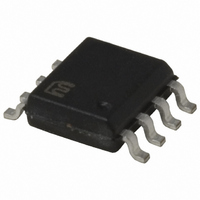MIC184BM Micrel Inc, MIC184BM Datasheet - Page 17

MIC184BM
Manufacturer Part Number
MIC184BM
Description
IC SUPERVISOR LOCAL/REMOTE 8SOIC
Manufacturer
Micrel Inc
Datasheet
1.MIC184YM.pdf
(20 pages)
Specifications of MIC184BM
Function
Temp Monitoring System (Sensor)
Topology
ADC (Sigma Delta), Register Bank
Sensor Type
External & Internal
Sensing Temperature
-55°C ~ 125°C, External Sensor
Output Type
I²C™/SMBus™
Output Alarm
Yes
Output Fan
No
Voltage - Supply
2.7 V ~ 5.5 V
Operating Temperature
-55°C ~ 125°C
Mounting Type
Surface Mount
Package / Case
8-SOIC (3.9mm Width)
Lead Free Status / RoHS Status
Contains lead / RoHS non-compliant
Available stocks
Company
Part Number
Manufacturer
Quantity
Price
Part Number:
MIC184BMM
Manufacturer:
MICREL/麦瑞
Quantity:
20 000
in most systems this will not be an issue.
Filter Capacitor Selection
When using a remote diode for temperature sensing, it is
sometimes desirable to use a filter capacitor between the
A2/T1 and GND pins of the MIC184. The use of this capaci-
tor is recommended in environments with a significant high
frequency noise (such as digital switching noise), or if long
wires are used to connect to the remote diode. The maximum
recommended total capacitance from the A2/T1 pin to GND
is 2700pF. This usually suggests the use of a 2200pF NP0
or C0G ceramic capacitor with a 10% tolerance.
If the remote diode is to be at a distance of more than 6" ~
12" from the MIC184, using a shielded cable (solid foil shield
microphone cable is a good choice) for the connections to the
diode can significantly help reduce noise pickup. Remember
to subtract the cable's conductor-to-shield capacitance from
the 2700pF maximum total capacitance.
Layout Considerations
Local Mode Only Applications:
If the MIC184 is not going to be used with an external diode,
the best layout is one which keeps it thermally coupled to the
subsystem(s) whose temperature it must monitor, while avoid-
ing any strong sources of EMI, RFI, or electrostatically coupled
noise. Two of the most common examples of such sources
are switching power supply transformers and CRTs.
Remote Mode Applications:
May 2006
MIC184
1.
2. Since any conductance from the various volt-
MIC184 will be used in an application, place the
MIC184 as close to the remote diode as pos-
sible, while taking care to avoid severe noise
sources (high frequency power transformers,
CRTs, memory and data busses, and the like).
ages on the PC Board and the A2/T1 pin can
induce serious errors, it is good practice to guard
the remote diode’s emitter trace with a pair of
ground traces. These ground traces should be
returned to the MIC184’s own ground pin. They
should not be grounded at any other part of their
run. However, it is highly desirable to use these
guard traces to carry the diode’s own ground
return back to the ground pin of the MIC184,
thereby providing a Kelvin connection for the
base of the diode. See Figure 8.
If the remote sensing capability of the
17
3. When using the MIC184 to sense the tempera-
4. Due to the small currents involved in the mea-
5. In general, wider traces for the ground and
6. Always place a good quality V
7. When the MIC184 is being powered from par-
ture of a processor or other device which has an
integral on-board “diode” (e.g., Intel’s Pentium
III), connect the emitter and base of the remote
sensor to the MIC184 using the guard traces
and Kelvin return shown in Figure 8. The col-
lector of the remote “diode” is inaccessible to
the user on these types of chips. To allow for
this, the MIC184 has superb rejection of noise
appearing from collector to GND, as long as the
base to ground connection is relatively quiet.
surement of the remote diode’s ΔV
important to adequately clean the PC board after
soldering. This is most likely to show up as an
issue in some situations where water-soluble
soldering fluxes are used.
A2/T1 pins will help reduce susceptibility to radi-
ated noise (wider traces are less inductive). Use
trace widths and spacing of 10 mils wherever
possible. Wherever possible, place a ground
plane under the MIC184, and under the connec-
tions from the MIC184 to the remote diode. This
will help guard against stray noise pickup.
pacitor directly adjacent to, or underneath, the
MIC184. This part should be a 0.1µF ceramic
capacitor. Surface-mount parts provide the best
bypassing because of their low inductance.
ticularly noisy power supplies, or from supplies
which may have sudden high-amplitude spikes
appearing on them, it can be helpful to add ad-
ditional power supply filtering. This should be
implemented as a 100Ω resistor in series with
the part’s V
capacitor from V
DD
pin, and a 4.7µF, 6.3V electrolytic
DD
to GND. See Figure 9.
DD
bypass ca-
BE
, it is
MIC184
®
Micrel












